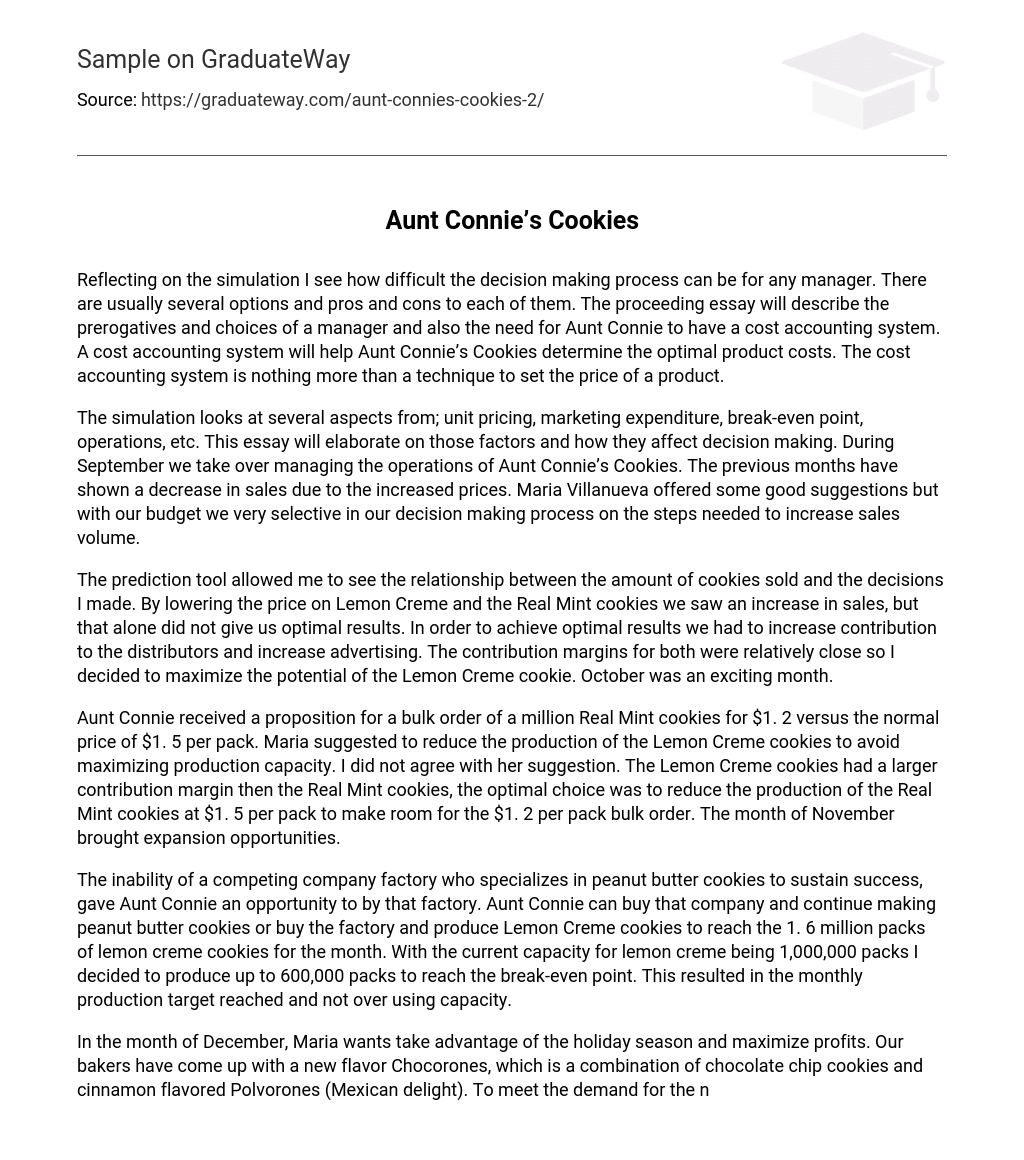After reflecting on the simulation, I acknowledge the challenges managers encounter in decision-making. They often have to deal with various options, each having its own pros and cons. This essay will explore a manager’s responsibilities and choices, as well as emphasize the significance of Aunt Connie implementing a cost accounting system. By doing so, Aunt Connie’s Cookies will be able to ascertain the most efficient product costs. Essentially, a cost accounting system is a tool that assists in determining product prices.
The simulation examines various factors such as unit pricing, marketing expenditure, break-even point, and operations, among others. This essay will discuss these factors and their impact on decision making. In September, we assumed responsibility for managing Aunt Connie’s Cookies. Previous months have seen a decline in sales attributed to higher prices. While Maria Villanueva proposed some valuable ideas, we must be cautious with our budget and carefully consider the steps necessary to boost sales volume.
The prediction tool enabled me to observe the connection between the sales volume of cookies and my decision-making process. When I reduced the price of Lemon Creme and Real Mint cookies, we witnessed a rise in sales. However, this action alone did not lead us to achieve the best possible outcomes. To attain optimal results, we had to enhance our contribution to the distributors and intensify our advertising efforts. The contribution margins for both cookies were fairly similar, which led me to focus on maximizing the potential of the Lemon Creme variety. October proved to be a thrilling month.
Aunt Connie received an offer for a large order of one million Real Mint cookies at a discounted price of $1.2 per pack, compared to the regular price of $1.5 per pack. Maria proposed reducing the production of Lemon Creme cookies in order to accommodate the increased production capacity. However, I disagreed with her suggestion because the Lemon Creme cookies had a higher contribution margin than the Real Mint cookies. Therefore, the best decision was to decrease the production of Real Mint cookies at $1.5 per pack and make space for the bulk order priced at $1.2 per pack. The month of November presented opportunities for expansion.
Aunt Connie had the chance to buy a factory that specializes in peanut butter cookies after it failed to sustain success. She can either buy the company and continue making peanut butter cookies or buy the factory and start producing Lemon Creme cookies to meet the goal of 1.6 million packs per month. Since the factory’s current capacity for Lemon Creme is 1,000,000 packs, I decided to produce up to 600,000 packs to break even. This allowed us to reach our monthly production target without exceeding the capacity.
In December, Maria aims to capitalize on the holiday season and optimize profits. Our bakers have developed a new flavor called Chocorones, which combines chocolate chip cookies with cinnamon-flavored Polvorones (a Mexican delicacy). To meet the demand for this new product, I had two choices: increase labor or equipment. The indifference calculator established the indifference point at 1,000,000 sales. I opted for the safer route and chose to increase labor.
The impact on the profit margin is less significant when revenue decreases due to a lower fixed cost and higher variable cost. Conversely, an equipment-intensive operation has a higher fixed cost and lower variable cost, resulting in a higher profit margin during periods of high sales volumes. However, the negative impact on the profit margin can be severe if sales volumes are low. For example, Aunt Connie would need 200 (‘000) in sales to be profitable with the labor-intensive solution, whereas the equipment-intensive solution requires 500 (‘000) in sales.
The need for a cost accounting system is evident for Aunt Connie’s Cookies due to various scenarios. It is recommended that Aunt Connie’s Cookies adopt an activity-based costing system, which is well-known and comprehensive. This system is preferred over a traditional costing system that lacks the ability to accumulate or report costs related to activities or processes. Traditional costing systems are usually general in nature, often utilizing a single cost pool for all indirect manufacturing costs. The cost-allocation base in these systems is primarily labor cost and/or labor hours.
This type of costing system is more effective with a simple production and is generally less precise compared to the activity-based costing system. The simulation provided details on indirect resource costs for various activities involved in the development and sale of cookies such as marketing, contribution to distributors, cost of acquiring another business, and determining the course of action for that business. These indirect resource costs can all be taken into account. The ABC system would provide Aunt Connie with highly accurate product or customer costs which can be utilized for strategic decision-making in the future.
The cost reporting of each activity helps Aunt Connie see the relationship between daily activities and cookie production. This simulation provided me with a firsthand understanding of the difficulty an accounting manager faces when making decisions. It made me recognize that to achieve growth or maintain success as a business owner, having a cost accounting system is essential.
The text mentions the book “Introduction to Management Accounting” by Horngren, Sunden, and Stratton. The book is in its 14th edition and was published by Prentice-Hall in Upper Saddle River, NJ in 2008.





